Improvement Theme is a tool in the form of a poster that works as a conveyor belt for continuous improvements once the Retrospective is over.
I’ve been reading a little bit about Toyota Kata and seen great presentations on the concept. In order to make it practical and useful for me I found myself tweaking it and packaging it in a concept I’ve come to call Improvement Theme. I’ve tried this concept a couple of times now and found it to be a good tool to extend improvements beyond the Retrospective and bringing it into the daily work. In this article I describe how to create the poster and how to use it as a tool for continuous improvements.
The Improvement Theme is a poster. I’ve been using magic charts since they are easily moved between the room in which the retrospective is held and the teams wall.
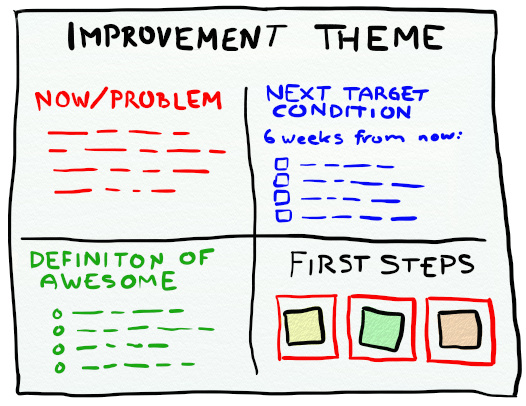 The charter consists of five areas.
The charter consists of five areas.
1. Name of the Improvement Theme
2. Now/Problem – Description of the current situation
3. Definition of Awesome – How would we like it to be?
4. Next Target Condition – X weeks from now, what has changed?
5. First Steps – 3 slots for three post-its that describe the first (next) actions we will take?
It’s a living document, preferable put up next to the scrum/kanban wall. Once or twice a week the team reviews the theme and agrees upon new actions as they get completed.
When X weeks has passed the team does a review of the theme itself. If they want to continue on the same theme they identify a new “Next target condition”. Otherwise they create a new Improvement Theme poster.
Here follows an extensive description of how I’ve been using the concept as a tool for improvement and a more in-depth description of the different aspects of the poster.
1. Gather suggestions for themes
We can’t change everything at once; let’s focus on one area at a time. If there isn’t a single obvious problematic area we need a way to gather suggestions for areas of improvement.
A way to present it to the team is to ask for topics for further discussions in areas you think we can and should improve. Improvement Theme suggestions goes onto post-its which then goes onto the wall.
Another way, which I prefer, is not to jump directly into suggesting themes but instead have the themes emerge. I’ve tried two different approaches so far.
1.a Jimmy Cards
Run a couple of rounds of Jimmy Cards. Between each round give the team a couple of minutes to think about the discussions that took place and write down Improvement Theme suggestions. They don’t have to be directly related to the discussion, don’t limit yourself if your inspiration takes you elsewhere. When all rounds are over (or timebox ends) the themes are presented and put up onto the wall.
In this blog post you can read how this played out when a colleague ran a retrospective with two teams simultaneously using Jimmy Cards.
1.b Good/Bad/Could be improved
Run a “standard” retrospective, gathering comments and reflections on what has been good and what could be better. I personally like people to reflect and put up notes in the following categories:
- Good – I’m happy this happened
- Appreciation – Thank you for <contribution/help/effort/insight/etc>
- Frustrations – Things that make me frustrated. This have to change.
- More! – We need to do more of this
- (Sometimes I add the category “Mysteries” – Things I don’t understand. How come…? Why is it that…?)
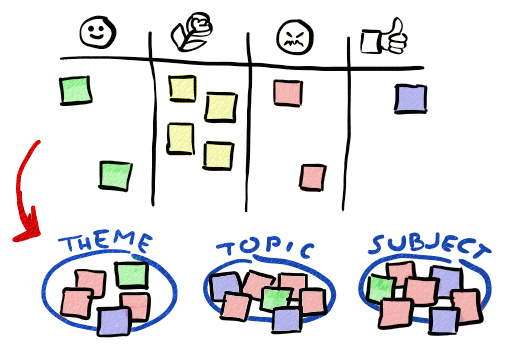 Once all the post-its are up we don’t jump into identifying improvements or retrospective actions. Instead we draw a couple of circles and then tries to find patterns. We move related notes into the circles and then finally label the circles. Not all notes needs to end up in circles.
Once all the post-its are up we don’t jump into identifying improvements or retrospective actions. Instead we draw a couple of circles and then tries to find patterns. We move related notes into the circles and then finally label the circles. Not all notes needs to end up in circles.
The labels then become the Improvement Theme suggestions. And as a bonus we have some input data for further discussions.
2. Choose an Improvement Theme
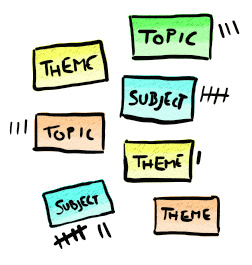 Through voting, or discussion, select a theme to focus on.
Through voting, or discussion, select a theme to focus on.
If it is a very big team (>10 people) perhaps there is enough people to work on two Improvement Themes. If you choose to work on two (or more themes) have the group split into smaller groups that focuses on a single theme for the remainder of the workshop. You might also want to insert breaks where the sub-teams present their progress so far once or twice during the remainder of the exercise.
3. Explain the Improvement Theme charter
Draw the improvement theme charter and briefly explain the different areas and how the rest of the exercise will be executed.
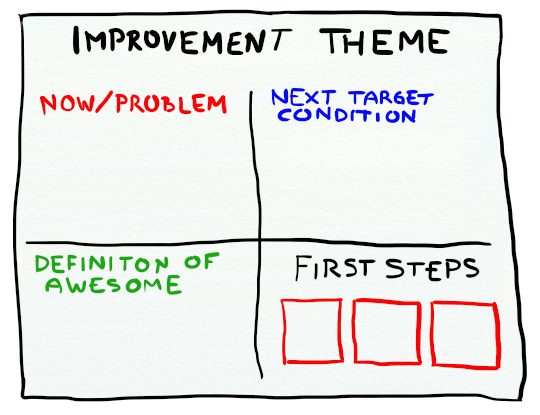
4. Now/Problem – Create a shared understanding of the current situation
To be able to get a buy-in from everyone we need a shared understanding of the current situation and the problem. Give everyone two minutes to individually write down their views on the current situation/problem on post-its. Then everyone presents and explains their notes. The post-its are NOT put onto the poster, they are put next to the poster. Once all notes are up, the team is given the task to summarize the “Now/Problem” in a couple of sentences or bullets. This two-step process is important since it builds a shared understanding and surfaces different views on the situation.
5. Define “Definition of Awesome”
Ask the team how they would like the world to look like? If it worked as they wanted, how would that look and feel like? The “Definition of Awesome” can be a distant vision, perhaps not even realistic within a year. That’s not the point. The point is to create a joint vision of the goal to strive towards.
I usually ask the team to describe this vision in a couple of bullets (max 5) or in a couple of sentences (max 3) and ask them to write them together. This can of course require a bit of discussion – which is a good thing.
6. (Re-)name of the Improvement Theme
Now that we have a shared view of the current situation and the problem, and have created a vision of how we want it to be in our Definition of Awesome, we might want to modify or change the name of the theme itself. Write the name on top (where the illustrations say “Improvement Theme”) on the poster.
7. Describe first target condition
Identify a first realistic sub-goal on our journey towards our vision – the Next Target Condition. Select a timespan and create a checklist of three to four things you want to be true by then. For example: “6 weeks from now, the following is true:” followed by a list statements describing things that have changed.
The statements should be easily evaluated and leave little room for interpretation. Either our improved way of working allows us the check the checkbox, or it doesn’t. (For example; “Better testing” is too vague. “We obey the testing aspect of our Definition of Done” is concrete. “Weekly sync meetings with team X” is better than “Fewer frustrations with dependencies to team X”.)
8. Identify first possible steps
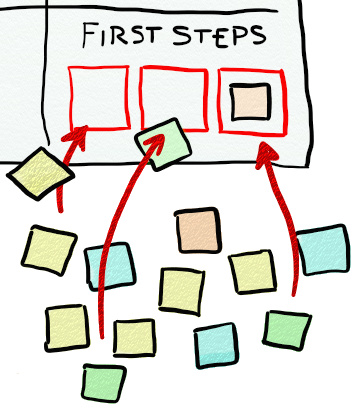 How do you eat an elephant? Yes, one bite at a time. Same goes for change.
How do you eat an elephant? Yes, one bite at a time. Same goes for change.
Start with brainstorming ideas for possible small actions the team can take in order to get closer to the described Next Target Condition. If it’s a big task ask yourself, what would you start with? Make that into an action. Don’t shoot down suggestions or censor wacky ideas now.
The actions don’t have to describe a complete plan on how to reach the next target. We want to figure out a couple of small steps we can start with.
Once a bunch of possible actions has been identified, select (through voting or discussion) which three will become our First Steps. These three post-its goes into the three red squares, the place holders for todo actions. Finally assign responsible persons to the actions.
9. Make it regular
Select when you review and update the
One team I coach reviews the status of their “First steps” every Tuesday and Thursday immediately after the daily stand-up. They review their actions, asks what needs to be done to “check them off”, etc. If a task is completed they move it to the “score board” and then fills the empty box with a new action. That new action could be one of those identified during the retrospective or a totally new idea. Whatever brings the team closer to the Next Target Condition.

10. Decide upon when to follow up and re-evaluate
If possible, book a review meeting immediately. When the date of “Next target Condition” is up it is time to reflect upon the Improvement Theme. We ask ourselves
* Did we reach the target condition?
* How much have we moved away from “Now/Problem”?
* How much closer are we to our “Definition of Awesome”?
* Does our theme still feel relevant? If yes, identify a new Next Target Condition. If not, create a new Improvement Theme poster.
Good Luck and Happy Improving! 🙂




Brilliant stuff, thx for writing it up!
Really like the approach!
Very interesting post. We just started experimenting with this in our last sprint. One of the things, we would also like to capture is the root cause analysis that we do as part of our retrospective. Good idea? Bad idea?
I think it is a great idea! Root cause analysis tends to spur great discussions and provide deeper insights during the “Now/Problem” phase. If you haven’t yet, go give it a try!
I suspect the actions you list will be of higher impact and relevans if you do a root cause analysis.
Very good…
Hi
I really really like this and will try to use it.
Thank you very much for sharing
Sinéad
Hi!
Great initiative. However, why not use Toyota KATA (TK) as is instead of having some kind of tweaked version?
TK do connect the team improvement work, through a Challenge, to a Vision.
Also, it do support making improvement in steps and is team based.
Br
Karl-Erik
The simple answer I guess is that I tried this out and it worked very well with the teams I work with. The examples I saw of Toyota Kata were to heavy weight for my needs and the teams need at that moment i time.
/Jimmy
Okay!
However, the TK is quite simple as is and I am a little bit surprised that you think TK is heavyweight.
I have coached some teams doing Improvement KATA and they do not feel it is heavyweight at all.
It is the coach (the one who performs the Coaching KATA) who needs to be relatively experienced when asking the questions.
I am suspecting that you just need to change it to something that gets a Crisp touch.
There is a lot of research that resulted in TK and now you are suboptimizing it. I think you should change the blog heading to something like “.. inspired by Toyotak KATA …” or remove the reference completely to TK.
Br
Karl-Erik
Thanks for your feedback Karl-Erik!
You might be right. Perhaps I should give the Improvement KATA one more try.
But no, I didn’t need to tweak it to get a Crisp touch 🙂 In this article I simply describe a tool we tried out for making long term continuous improvements part of the teams routine. It was inspired by TK and the idea has proven to be useful for a couple of teams I’m working with. Perhaps TK would have been equally (or more) useful.
I don’t hope I’m suboptimizing anything. Could you elaborate?
Best Regards
/Jimmy
Hello!
Sorry for late reply. The TK suboptimization that you do with your tweaking is summarized here:
TK: Vision Crisp: N/A
TK: Challenge Crisp: Definition of awesome (maybe) (*)
TK: Current Condition Crisp: Now/Problem (*)
– The Crisp method do not catch one of the more important parts and that is understanding how things operates currently, Crisp mixes problems with current condition.
TK: Target Condition Crisp: Target Condition (*)
TK: PDCA cycle Crisp: First steps
– TK mandates one step at a time, Crisp is unclear. Also, the TK hypothesis is untouched by Crisp (i.e. what o you expect (after takeing that step) …)
TK: Coaching Kata (CK) Crisp: N/A
– The lack of CK is a big difference vs. TK
(*) It lacks metrics/measurements (process and outcome).
I hope this explains the suboptimization part.’
Nonetheless, I think Your method is not bad, but do not call it something like Simple Toyota Kata, please. Pehaps inspired by TK is better.
Br
Karl-Erik
Great work Jimmy!
Taking and idea/method/tool and recreating it yourself for you context is often a great way to learn and get buy-in in your organization. I have also done some modifications and translations of the Toyota Kata material when I felt it was needed to get started. Because I think getting started on the continuous improvement journey is more important than the tools or methods themselves.
A few things that I have learned using something similar to your Improvement Theme compared to using the Improvement Kata and Coaching Kata are:
If we don’t include a learning step for EACH action we are missing out of one of the biggest benefits of continuous improvements. Take a look at this slideshare by Mike Rother: PDCA – Learning Along the Way
By jumping into actions/solutions to early it is very common that we will only focus on doing/implementing the action/solutions without reflecting if they really resolved the problem. If we build a list of problems/obstacles first and then think of experiments to try to remove the problems/obstacles. You then run one experiment at a time and see if the experiment resolved the problem. Doing it this way often create a different frame and more learning as a result.
One simple change to your improvement Theme may be to have the lower right part more reflect the PDCA learning cycle. Maybe try have the following four squares for each experiment.
Experiment/Step – this should describe the Experiment/Step you want to try to resolve the current problem
What do you expect – this should be a prediction of what will be the result of running the experiment
What happened – this should describe what really happened, what the result/outcome was
What we learned – this is the most important step. Here we put the learning we had by doing the experiment. The delta between What we expect and What happened will help you reflect and learn. This learning should then feed back into the next experiment.
/ Håkan Forss
Thank you very much Håkan for your feedback and your suggestions on how to expand and improve this tool. I never intended it to capture everything that the Improvement Kata and Coaching Kata encapsulates. I assume that people will adopt the Improvement Theme for their own needs, and hopefully also compare it to what Toyota Kata offers, as well as takes yours (and others) suggestions for how to change and expand it. I love your altered 4th square. I think the reason we left that part out of the poster when initially created was that we asked ourselves those questions during the teams retrospective.
Again, thank you!
/Jimmy
Ok Jimmy. Now then, after the comments by one of the more experienced and knowledgable persons on TK out there, will you change the heading in this blog? (:-))
The PDCA cycle is absolutely fundamental (hypothesis testing and learning after each step) in TK. This is lacking (as I also pointed out above) in the “.. simple and practical Toyota Kata”.
Call it something like “… Crisps Improvement theme method ..” or similar. Make your own brand instead :-)!
Also, with no Shared vision and connection to the Challenge you will not know if you are heading in the right direction.
By the way, your definition of a Target Condition is not according to Toyota Kata definition. I will not explain the difference. That is something I leave to you :-)!
Again, I think it would be better to start to use TK as is (since it is simpe as is, but with fundamental key points), then adapt it (but not leaving out the essentials, as Mike Rother and others very clearly points out).
Br
Karl-Erik
PS: Anyhow, having a systematic/structured improvement WoW is good thinking.
How long have you found this process takes?
One hour is sometimes sufficient to create the first poster. Then the team continues working on the same theme as long as it makes sense. When they review the theme after a couple of weeks it might make sense to continue working on the same, or to create a new one.
This is a great way of making change and continuous improvement visible, manageable, and tangible. It is also a great taster for those who to want to go on to using the Toyota Kata. The ‘Improvement Theme’ itself is quite powerful on its own.
I got to introduce and apply this in a number of environments now. One application is a leader who is using it now to further develop their leadership approach. Another application, quite along the lines of this post, is a couple of teams that use it as a framework for their improvement; their retros feed into that. A third example is my own use of it for improving my business as an independent.
❤ it.
Thanks!
Looks like model GROW
Thanks. Really like it.
Found this post in 2021 but it is still relevant and very useful!